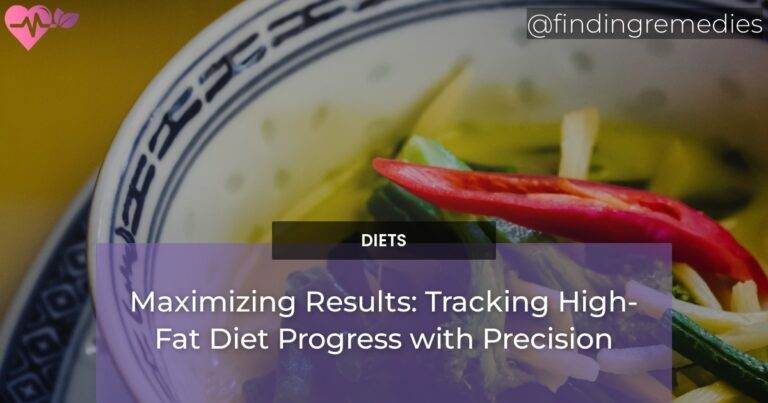Following a high-fat diet, such as a ketogenic or low-carb diet, has numerous benefits for our health and well-being. But tracking progress can be challenging, especially when trying to determine the right macronutrient ratios and using accurate and reliable tracking methods. In this article, we will explore the best practices and tools for tracking progress on a high-fat diet, including tracking macronutrient intake, using food journals, taking regular body measurements, using body fat calipers, getting blood tests, wearing fitness trackers, tracking exercise and physical activity, and regular check-ins with a nutritionist or healthcare professional.
Table of Contents
Benefits of a High-Fat Diet
A high-fat diet has been shown to have numerous benefits for our health and well-being, including:
- Improved mental clarity and focus
- Increased energy levels
- More stable blood sugar levels
- Reduced inflammation
However, tracking progress on a high-fat diet can be challenging due to several common roadblocks.
Common Roadblocks to Progress Tracking
Some of the common roadblocks to tracking progress on a high-fat diet include:
- Difficulty in determining the right macronutrient ratios
- Lack of accurate and reliable tracking methods
- Plateaus in weight loss or muscle gain
- Inconsistent adherence to the diet
Let’s explore some of the best practices and tools for overcoming these roadblocks and tracking progress effectively.
Tracking Macronutrient Intake
Tracking macronutrient intake is essential on a high-fat diet to ensure that you are consuming the right amount of fats, proteins, and carbohydrates. It can help you determine the ideal macronutrient ratios for your body and achieve your desired goals, such as weight loss or muscle gain.
Some popular apps and tools for tracking macronutrient intake include:
- MyFitnessPal
- Cronometer
- FatSecret
- Carb Manager
Using these apps can help you monitor your macronutrient intake and adjust your diet accordingly.
Use of Food Journals
Keeping a food journal is another effective way to track progress on a high-fat diet. It can help you identify patterns in your eating habits and make adjustments accordingly. Here are some tips for creating an effective food journal:
- Record everything you eat and drink
- Include portion sizes and preparation methods
- Note any symptoms or reactions you experience
- Be consistent and honest
Using a food journal consistently can help you stay on track and achieve your desired goals.
Regular Body Measurements
Tracking your body composition regularly can help you monitor your progress on a high-fat diet. Here are some tips for taking regular body measurements:
- Measure at the same time of day and under the same conditions
- Use a tape measure for accurate measurements
- Measure your waist, hips, thighs, and arms
- Track your progress over time
Regular body measurements can help you stay motivated and make adjustments to your diet and exercise routine.
Use of Body Fat Calipers
Body fat calipers are another tool for tracking progress on a high-fat diet. They can help you measure your body fat percentage and track changes over time. Here are some tips for using body fat calipers effectively:
- Follow the instructions carefully
- Take multiple measurements and average them
- Measure at the same time of day and under the same conditions
- Track your progress over time
Body fat calipers can be a useful tool for tracking progress, but they have some limitations, such as not being accurate for certain body types.
Blood Tests
Blood tests can be an essential tool for tracking progress on a high-fat diet. They can help you monitor key biomarkers, such as ketone levels, glucose levels, insulin resistance, inflammation, and micronutrients. Here are some tips for getting blood tests:
- Work with a healthcare professional to determine which tests are necessary
- Get tested regularly to track changes over time
- Consider more comprehensive tests, such as DEXA scans or bioimpedance analysis
Blood tests can provide valuable insights into your progress and help you make adjustments to your diet and exercise routine.
Use of Wearable Fitness Trackers
Wearable fitness trackers can be another useful tool for tracking progress on a high-fat diet. They can help you monitor your physical activity, heart rate, and sleep patterns. Here are some popular wearable fitness trackers for tracking progress:
- Fitbit
- Apple Watch
- Garmin
- Polar
While wearable fitness trackers can be helpful, they have some limitations, such as not being accurate for certain activities or body types.
Tracking Exercise and Physical Activity
Tracking your exercise and physical activity is essential on a high-fat diet to ensure that you are getting enough movement and burning enough calories. Here are some popular apps and tools for tracking exercise and physical activity:
- Fitbit
- MyFitnessPal
- MapMyFitness
- Strava
Using these apps can help you stay motivated and achieve your desired goals.
Regular Check-Ins with a Nutritionist or Healthcare Professional
Regular check-ins with a nutritionist or healthcare professional can be essential on a high-fat diet to ensure that you are on the right track and making progress toward your goals. Here’s what to expect during a check-in:
- Review of your progress and challenges
- Recommendations for adjustments to your diet and exercise routine
- Evaluation of your overall health and well-being
Working with a qualified nutritionist or healthcare professional can provide valuable support and guidance on your high-fat diet journey.
Conclusion
Tracking progress on a high-fat diet can be challenging, but using the best practices and tools can help you overcome common roadblocks and achieve your desired goals. By tracking macronutrient intake, using food journals, taking regular body measurements, using body fat calipers, getting blood tests, wearing fitness trackers, tracking exercise and physical activity, and regular check-ins with a nutritionist or healthcare professional, you can ensure that you are making progress and achieving optimal health and well-being.

